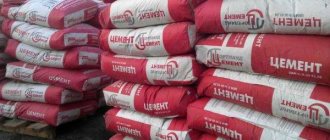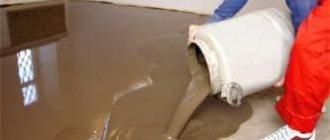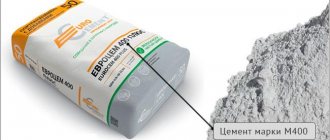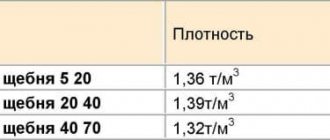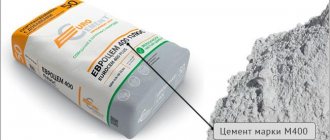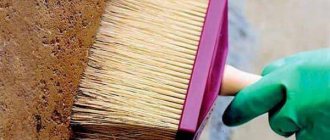How to prepare a solution at sub-zero temperatures?
At -5 degrees there is no need to add additives. In colder conditions, it is necessary to use special products, because the seams may simply crumble. It is also worth taking the main components seriously. For example, difficulties arise with frozen sand.
To prevent this from happening, you need to do it in advance. It can also be placed in a room with a warm temperature regime. The water should be warm or hot. With it, the solution will not freeze.
In addition, the detergent dissolves much better at warm temperatures. In the winter season, you also need to take into account the fact that you need to add anti-corrosion agents.
The specific gravity of cement is a certain indicator of its density and depends on the brand of cement. It is determined by the ingredients of the solution used and the purpose of their use.
Composition of concrete M150
The composition of this type of building material is traditional for heavy concrete: cement, sand, crushed stone and water. At the same time, various additives and additives are used to impart special properties to concrete.
Traditionally, the following material is used: Portland cement CEM I 32.5N PC (M400) or CEM I 42.5N PC (M400) as the most affordable, quarry sand and crushed granite stone of 20-40 mm fraction.
As an option, river sand and crushed gravel can be used, and in non-critical cases, construction waste can be used instead of crushed stone: broken bricks, pieces of plaster, broken tiles, etc.
Varieties
Cement is a binding substance that can harden in water, as well as when exposed to air. Its main component is clinker. Cement is made by grinding clinker from gypsum and adding mineral additives.
Clinker may include: limestone, nepheline sludge, marl. After adding 20% of mineral additives from the entire mass of the prepared liquid, the characteristics and trends of the source material change. If the volume of additives is more than 20%, then pozzolanic cement is formed.
Due to the active use of cement for the purpose of carrying out work in the construction industry, there are several varieties of it. They differ from each other in composition.
Types of cement include:
- marly;
- lime;
- clay cement in addition to additives of bauxite and slag. It differs from all others in its water resistance;
- sulfate-resistant, which hardens very slowly and has increased frost resistance;
Sulfate resistant
- grouting. It is intended for concreting oil wells;
- the strainer dries quickly;
- hydraulic;
Main properties of cement
- Freezing period. It is determined by laying medium-thick cement on a smooth surface. As it dries, it will evenly change its volume.
- Density. Using water to make a cement mixture. After the cement has hardened, water is needed to dry it and also for further good installation.
- Coupling with reinforcement cage. After preparing the solution, it quickly adheres to the reinforcing material.
- Heat dissipation . During hardening, heat is released from it. When this process occurs slowly, the coating hardens very evenly. Also, no cracking is observed in the cement. The time and amount of heat generated can be controlled using mineral elements. They are entirely intended to be added to the solution.
- Grinding grain size. This property affects the drying time and strength of cement. The smaller the grind, the better the strength of the cement.
- Frost resistance. If necessary, you can determine how much the prepared cement can withstand freezing water for some time. Subsequently, the volume of water can increase by 8-9%.
Adviсe
- It is very important to choose a trusted manufacturer of M150 sand cement. Despite the fact that the composition of all these products is almost identical, the physical properties may differ significantly, for example, in the grain size of cement or sand, frost resistance, the presence of impurities and other factors. Therefore, buying the M150 mixture cheaply does not mean it is profitable. You must carefully study the composition on the packaging, its warranty and shelf life, and purchase only from those manufacturers who have reliably proven themselves in the building materials market.
- After purchase, M150 mixtures must be stored unopened in a dry and dark room with a temperature of +10 to +35 degrees and a relative humidity of no more than 70%. Under such optimal conditions, the product retains its properties for 6 months; it is not recommended to store it without use for any longer.
- For the most effective use of the solution, the surface on which it is applied must be cleaned of large irregularities, fungus, mold, and moss. This will ensure better adhesion and less material consumption. It is also always recommended to prime the surface before use.
See the video below for the process of leveling walls with cement-sand mixture M150.
Floor screed calculator
One of the mandatory stages of building construction or major renovation is the installation of floors. This procedure is not limited to installing a decorative coating on the base. A screed is also required, which is necessary to transfer loads, level the surface and provide additional heat and sound insulation qualities.
There are three floor screed technologies:
- Wet (or traditional) - an inexpensive option using sand concrete;
- Dry – using dry material, which eliminates the need for “ripening” the layer;
- Semi-dry (mechanized) - an analogue of wet screed, which is produced using special equipment, speeds up and simplifies the procedure.
Next, let's talk about calculating floor screed using a calculator.
If we are talking about the wet method of pouring the floor, it is important to calculate the required height of this layer, taking into account the area of the room and differences in the surface on the base. The differences are calculated by the level, with the help of which at the first stage you need to set the zero limit in each room. The next step is the distance from the zero level to the floor. The resulting value is an indicator of the height difference. If the indicator is less than 20 mm, then a layer of material of the same 20 mm will be enough to complete the job.
The next step is purchasing materials for the screed. Conventionally, there are two ways to obtain the mixture – “manual” and “automatic”. That is, you can use a recipe for preparing a screed by mixing the required components in the required proportion, or you can simply buy a ready-made dry mixture. It is sold in bags in construction stores, and if you do not have experience in such tasks, it is better to use ready-made material, which you simply need to dilute with water. This is a guarantee that the screed will be reliable and durable - any miscalculation in consistency will lead to immediate problems.
But there is one tool that significantly simplifies the mechanics of measurement (it is relevant both for manual preparation of the mixture and for calculating the volume of the finished material). This is a floor screed calculator. We are talking about a simple calculation program that calculates the required amount of raw materials (taking into account the “correct” ratio of components).
All you need to know to calculate the screed consumption is the width and length of the room, as well as the height difference described above. To calculate floor screed with a calculator, use the formula:
Length * Width * Height = Volume of material.
Similar formulas are used in the Knauf dry screed calculator, which can be immediately ordered with unloading, delivery and installation.
That is, you enter the required values into the online floor screed calculator and press the “calculate” button. The floor screed calculator then provides information about the required volumes to complete the job: cement, sand and water, or a dry mixture from a bag and water.
When working with a mixture calculator for floor screed, it is important to consider that the volume of the finished solution is always less than the value of the individual dry components and water. In practice, it is about 70% of the original total value.
What kind of concrete is used for screed?
The choice of brand depends on the specifics of the task at hand. For example, in utility rooms and garages, concrete grade M150 will be sufficient. For residential premises of any type, M200 is most often used. When it comes to large regular loads on the floor, concrete grade M300 and higher is used.
To improve the quality of the screed, crushed stone of small fractions is added to the dry mixture. The strength of the material is increased due to special plasticizers, which are introduced into the solution during mixing. To prepare a high-quality solution, it is important to scrupulously adhere to the proportions of the components. The dry ingredients are mixed with water until the lumps disappear. Plasticizers must be thoroughly mixed in water.
Successfully calculate the floor screed with the calculator and complete the task in the best possible way!
Volume of a bag of sand concrete and number of bags in 1 cube
M-150
- 50 (kg) : 1450 (kg/m3) = 0.035 m³. There are 29 bags of 50 kg in a cube
- 40 (kg) : 1450 (kg/m3) = 0.028 m³. There are 36.25 40kg bags in a cube
- 25 (kg) : 1450 (kg/m3) = 0.017 m³. There are 58 bags of 25 kg in a cube
M-200
- 50 (kg) : 1512 (kg/m3) = 0.033 m³. There are 30.24 50kg bags in a cube
- 40 (kg) : 1512 (kg/m3) = 0.027 m³. There are 37.8 40kg bags in a cube
- 25 (kg) : 1512 (kg/m3) = 0.016 m³. There are 60.48 25kg bags in a cube
M-300
- 50 (kg) : 1428 (kg/m3) = 0.035 m³. There are 28.5 50kg bags in a cube
- 40 (kg) : 1428 (kg/m3) = 0.028 m³. There are 35.7 40kg bags in a cube
- 25 (kg) : 1428 (kg/m3) = 0.017 m³. There are 57.12 25kg bags in a cube
